The life and work of Artemisia Gentileschi is a direct insipartion for the creation and existence of this guild.
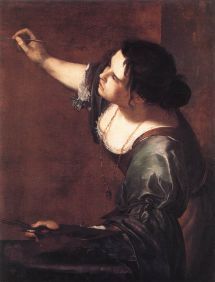
Selfportrait as the Allegory of Painting (1630s)
Artemisia Gentileschi (1593-1652)
She was born the 8th of July in Rome and was one of the leading painters of her time. She was daughter of Prudentia and Orazio, follower of Caravaggio and founder of the style known as Caravaggism. Caravaggio was a lawless bohemian artist who was said to be "as skilled with the dagger as with the paintbrush" (Chadwick), and his style was revolutionary and full of unrestrained passion. Artemisia Gentlieschi came to be one of the two most important Cavaraggisti (Bisell) of her time.
Her mother died when she was twelve and her father trained her as an artists in his workshop. He also introduced her to the working artist of Rome, including Michelangelo.
She married a Florentine with whom she had a daughter, and moved to Florens to work mainly for the Grand Duke Cosimo II of the Medici family, who commissioned quite a few paintings from her. In Florence she had an excellent reputation and painted many of her most important works, she also joined the honorable Academia del Disegno.
In 1620 she returned to Rome to continue her work there. She live as the head of the household with her daughter and two servants, apparently she had separated from her husband and lost touch with him. It is known that her daughter also was a painter, but none of her work has survived. Gentileschi's fame at the time was evident, amongst others by the production of a commemorative medal bearing her portrait. But she was both praised for her genious and destained because she was a woman exercising a creative talent thought to be exclusively male. Several contemporary painters made portraits of her describing her as a wise and noble woman of Rome.
When she moved to Naples in 1630 she was a celebrity and was under the patronage and protection of the nobility. There she collaborated with a number of other artists. At this time she painted, amongst others, Selfportrait as the Allegory of Painting (1630s) a work unique in the fusing of art, muse and artist.
In 1638 she moved to England to work together with her father Orazio at the court of Charles I of England. In 1639 her father died, but Gentileschi had her own commission to fullfill so she stayed in England. She returned to Naples in 1642 and lived and worked there until her death in 1652.
Work
In the 17th century there was a growth of naturalism which led to an emphasis on the depiction of courage and physical prowess. Focus was moved from broader narrative themes to a single dramatic moment that emphasized more violent and voyeuristic aspects. Popular scenes where taken from the Apocryphs.
Susanna and the Elders
Among the earliest work of Gentileschi is a Susanna and the Elders (1610) which displayes early evidence of her development. The theme taken from the Apocryphs of the attempted seduction of the two Elders of Joachim's wife, Susanna, was popular in Italy at the time. Susanna symbolized the Church and the Elders represented pagans and other opponents.
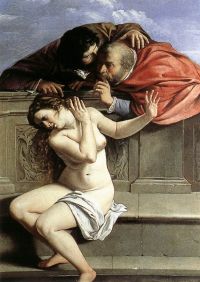 | 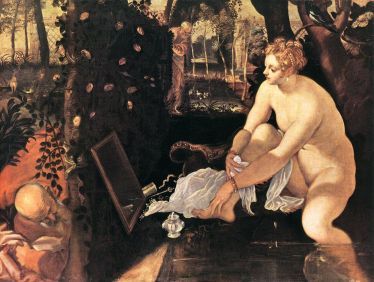 |
| Susanna and the Elders (1610) | Tintoretto Susanna and the Elders |
This theme often provided a Biblical occasion for the painting of an erotic nude, and Susanna was frequently assigned a complicitous role which emphasized the sexual dynamics (Chadwick). Gentileschi's version departs significantly from this tradition, she removes Susanna from the garden, metaphore of femininity and sexuality. Susannas awkward twisted body makes the image one of distress and resistance. Gentileschi transforms the conventions of 17th century painting and gives new content to the imagery.
Judith
The story from the Old Testament Apocrypha about the slaughter of the Assyrian general, Holofernes, by the Jewish widow, Judith, who crept through enemy lines and seduced and then decapitated the general was a popular theme at the time. During her time in Florens Gentileschi painted several variations of Judith Decapitating Holofernes and Judith with Her Maidservant Abra. The monumental composition, naturalistic rendering, the use of contemporary models and the strong contrasts of light and shadow, all indicate Gentileschi's adherence to the principles of fully developed Caravaggism.
 | 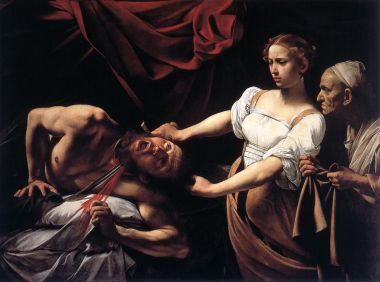 | 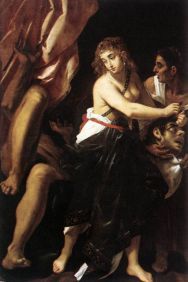 |
| Judith Decapitating Holofernes (c. 1618) | Caravaggio 1598 | Baglione 1608 |
The painting Judith Decapitating Holofernes, even though a common theme at the time, has attracted extensive commentary. Despite pictoral sources in Caravaggio, Rubens and Orazio Gentileschi, there is nothing in the history of Western painting to prepare us for Gentileschi's version (Chadwick). The ferocious energy and violence of the scene is brilliantly captured in the composition in which the vertical and diagonally thrusting arms meet at Holofernes's head. It is almost that one can sense the movements and the energy of the scene. Never before, and never again, has it been rendered in such a way.
Also interesting is the depiction of the two women, where other painters chose to follow conventions of coy glances, averted gazes and mannered elegance Gentileschi portrais two women in the critical moment of an act. Their faces express intense concentration and collaboration, their bodies are strained and tense.
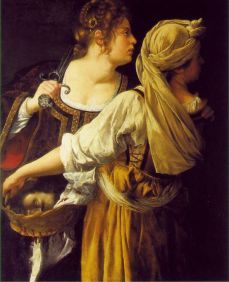 | 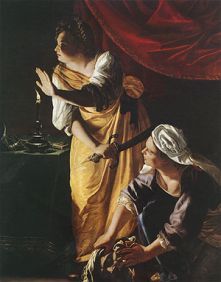 | 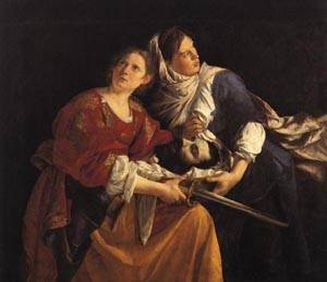 |
| Judith with Her Maidservant Abra (c 1618) | Judith with Her Maidservant Abra (c 1625) | Orazio Gentileschi |
In the first painting of Judith with Her Maidservant Abra Gentileschi emphasizes the psychological complicity of the two figures by squeezing them into the same space, facing them and repeating their gazes. The intensity of Judith's action, reinforced by the clenched hand that holds the sword, is a radical departure from Orazios version of the subject. Even so in the second version of the theme, the scene depicted is one of tense and grave understanding of the actions just performed - the killing of an enemy leader.
Even though there is little documentation of Gentileschi's life, her work speaks for itself. Her brilliant and sometimes controversial depiction of common themes of her time made a great impact in the future imagery of these. There is something in her work that makes it specially fascinating and interests art historians to this date.
References:
Chadwick, W. Women, Art and Society 3rd Edition
Garrard, M. D. Artemisia Gentileschi